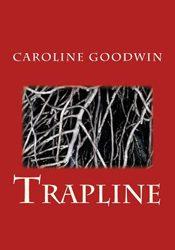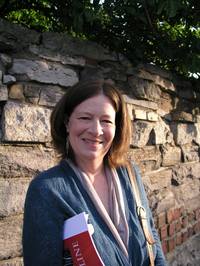
Though the title of Caroline Goodwin’s most recent collection first brings to mind the definition of a trapline as a “series of animal traps,” it is the other definition of “the ensnaring filament of a spider’s web” that better describes the mood of this collection of poems. In a language that stealthily weaves between the threads of nature and of humans, Goodwin’s Trapline instructs in stoicism, observation and patience as tools that may help one survive the webs that ensnare our dreams and desires. As readers we are invited, in the opening poem, “Invitation,” to be like “an iris surrendering its pupil,” to be voyeurs to a world that is neither unforgiving nor welcoming, a world less about comfort than endurance.
Though Goodwin draws on her background in biology and her life in Alaska, this is not a confessional narrative of loss of innocence or alienation in marriage, though these are themes that recur through out the book. Rather, these poems inventory and observe. First, there is the inventorying of a landscape and the people who populate it, starting with “Invitation” and recurring through poems such as “Inventory” and “Things the Man Carried with him to Big Port Walter.” In this later poem, both objects and people are examined through the language of nature – the plate holds “Venison, rockfish… the perfect/course of oxygen,” and the wife’s desire is revealed through “a lean cat/on her lap.” As this “wife” stanza closes, the subject grows ambiguous (it is unclear if it is the cat or the wife that is being spoken of here) blurring, as Goodwin often does, the line between people and nature:
Almost asleep, you think you make out
her breath, the rasp of abalone
scraping the walls of the abyss. Imagine
how strong they are, pink flesh pulling
to the rock with a single touch. Your tongue
swirling in the empty, iridescent shell.
The voice of these poems resists confession as it resides in personas that observe rather than tell a story or act out a scene. There is an absence of an ‘I’ and Goodwin’s use of the 2ndrather than drawing the reader in as subject, emphasizes the distances and accentuates the voyeuristic quality of this work. We are not asked to be the wife with the “Rope of pearls at her throat” who only can imagine the fulfillment of desire in the sleeping cat as much as we are being made to look at this other being spoken to by the speaker of the poem. Even when people connect in these poems, it is a connection that is intent upon not disturbing, upon containment over release, as in the lovemaking in the second section of “While-Lined Sphinx:”
It always amazed me, how we fit
and how not a sound escaped you. Nothing.
Not a moan, not a gasp. Not a wind
in the saltmarsh, but a sucking
sound, in the distance, a hoofed animal
laboring to cross the mudflats.
Thus, Goodwin’s images converge the human nature with the nature of the animals and plants that surround them until it inverts the idea of the human as trapper and nature as something that can be trapped. Sudden movement is suspect and dangerous in this book.
The language, form and images of the poems resign themselves to a stoicism that seems the only option in a world of pioneer hardships and limitations: limitations of gender roles and limitations imposed by the unforgiving environments. The forms are tight and controlled, though not of traditional form. Yet, underlying all this is the desire for escape and freedom felt in the book’s opening and closing images of feathers and birds. Starting in the first three poems, feathers are like talismans for creativity and escape: “come/ after work when the mind // has grown plumes.” Goodwin subtly infuses the presence of the feather as the silent longing for something more than the relentless “laboring” of nature. The second poem carries this idea further with “Mother, Birdsong” where plucking of hairs and feathers and leads to a splitting of the self and the third poem in the book more pointedly asks, “Whose/feather, whose expanse of skin?”
 Though absent for much of the book, the feathers return in the third section of “Winter Hatchery,” the first poem in the final section of the book. Also at this time, a stronger I emerges, one who is able to act, to save this owl “the fuzzy cup / of her skull about the size / of our child now.” There is hope in creation, in procreation – an action is taken to protect, preserve, and claim one’s self. Later, in “Song O’ Sixpence,” there is a vision of taking back the parts of the self that men have taken from the women in these poems (seen before in the “wife” section): “… but in her version the birds fly quickly away from the kind’s face, taking the song with them… ” leading to a place where women are not caught in a anyone’s trapline, “to a place where understanding / becomes a type of twin a chip of sun/ a solid thing coming up out of the inlet / shaped like our own hands.” This breaking out of the trappings of nature and of traditional roles is reflected in the prose-like structure of this poem, a departure from the tightly contained stanzas of the rest of the book.
Though absent for much of the book, the feathers return in the third section of “Winter Hatchery,” the first poem in the final section of the book. Also at this time, a stronger I emerges, one who is able to act, to save this owl “the fuzzy cup / of her skull about the size / of our child now.” There is hope in creation, in procreation – an action is taken to protect, preserve, and claim one’s self. Later, in “Song O’ Sixpence,” there is a vision of taking back the parts of the self that men have taken from the women in these poems (seen before in the “wife” section): “… but in her version the birds fly quickly away from the kind’s face, taking the song with them… ” leading to a place where women are not caught in a anyone’s trapline, “to a place where understanding / becomes a type of twin a chip of sun/ a solid thing coming up out of the inlet / shaped like our own hands.” This breaking out of the trappings of nature and of traditional roles is reflected in the prose-like structure of this poem, a departure from the tightly contained stanzas of the rest of the book.
Thus, with a heightened sense of awareness, a keenness of instinct, these poems both evade the trapline and are the filament to trap that which keeps us from our desires and ourselves.




